President of the Republic of Azerbaijan Ilham Aliyev met with members of the general public of Khojavand district on October 9, informs.
The head of state addressed the meeting.
Speech of President Ilham Aliyev
- Dear friends, it is the first anniversary of the liberation of Hadrut settlement today. I heartily congratulate you and all the people of Azerbaijan on this occasion. I think that to celebrate this day with you here in Hadrut is a very special event. After a long break, we have returned to Hadrut - Khojavand. We have returned through fighting, shedding blood and giving martyrs. May Allah rest the souls of all our martyrs in peace. It is at the cost of their blood, lives, the courage and heroism of our servicemen that we have restored historical justice, expelled the invaders from our native lands and returned to our native lands. A new era of Hadrut and Karabakh in general is beginning.
The Hadrut operation is one of the most important operations of the Second Karabakh War. This operation was of great importance both from a military and strategic point of view. The successful completion of this operation allowed us the opportunity to achieve our goal of liberating Karabakh. The location of Hadrut in this region is of special importance from a strategic point of view, because it is a mountainous area. The hills around the settlement provide control over a large area, and it was very difficult to liberate Hadrut from a military point of view. At the same time, the liberation of Hadrut opened up new opportunities for our future plans. I must also say that although there were more than 10,000 deserters in the Armenian army during the war and they hurriedly fled from some settlements, they put up strong resistance in Hadrut. The fierce fighting lasted here for several days. Nevertheless, they realized that they were helpless facing Azerbaijani soldiers and officers and were defeated here as well.
The significance of the Hadrut operation is that the Armenian leadership and the Armenian army did not expect that we would go to Hadrut after Jabrayil. They thought that we would go in the direction of Fuzuli. Although they had a large contingent in Hadrut, they did not expect us to come here. From a military point of view, the liberation of Hadrut required a lot of self-sacrifice and professionalism. By conducting this operation, we once again showed our strength to Armenia and the whole world. We have shown that no-one and nothing could stand in our way and that we would liberate all our lands at any cost.
The Azerbaijani public is well aware that there was a lot of false information in the Armenian media about the Hadrut operation. After we had already cleared all the mountains around Hadrut of the invaders, it became clear that the liberation of this settlement was simply a matter of time. We were determined to liberate the settlement with minimum losses, and we succeeded in doing that. The Armenian leadership and the Armenian defense ministry was stating that Hadrut was still in the hands of the Armenians. They claimed that they had allegedly resorted to another tactical retreat and had already returned to Hadrut by removing Azerbaijani soldiers from Hadrut. Seeing all these lies, I was simply amazed because it was crystal clear that Hadrut was already in our hands. I ordered that the Azerbaijani flag be raised in Hadrut to put an end to these lies of the Armenians. After that, after Azerbaijani soldiers and officers had raised our state flag in Hadrut and reported to me, the Armenian official propaganda admitted that Hadrut was under the control of the Azerbaijani Army.
This shows yet again that the Armenian propaganda was based on lies during the occupation, during the war and in the post-war period. Their history is false, their past is false, their statehood is false and their mythology is false. Armenians of the world have simply created the false impression in the countries where they live that the Armenian people have allegedly lived on these lands for centuries. The Armenians were resettled to Hadrut from Iran in the 19th century. Everyone knows that. There were no Armenians here prior to that. They have falsified history and are still falsifying the present-day realities. During the war, we heard many lies from the Armenian authorities. There was so much false, so much absurd information coming from their Ministry of Defense – it is probably worth changing its name to the ministry of falsehood – that the international experts and we were simply amazed. The extent of the lies about Hadrut had reached its peak. The liberation of Hadrut caused a profound moral and psychological shock in Armenia.
First of all, because they had believed that the Azerbaijani Army could never liberate Hadrut. Secondly because Hadrut was the administrative center of Hadrut district of the former Nagorno-Karabakh Autonomous Region. It was the center of the region. The Armenian leadership and the Armenian public were convinced that all our lands were our lands for us – whether it is Fuzuli, Jabrayil, Zangilan, Hadrut, Shusha or Sugovushan. The liberation of settlements of the former Nagorno-Karabakh Autonomous Region from the occupiers showed Armenia that we would not stop until Armenia undertakes to withdraw from all our lands, and we didn’t stop. After Armenia was ready to sign the act of capitulation and after we received information about that, we said that were stopping, we stopped and returned the remaining districts by political means.
Therefore, the Hadrut operation was of great strategic, historical, moral and psychological importance. Today, the former Hadrut district of the former Nagorno-Karabakh Autonomous Region is completely free of the occupiers. After the war had ended, a special sabotage group was sent to some villages of Hadrut district from Shirak region of Armenia. In late November, they crossed the Lachin corridor and entered these areas. As you know, they were disarmed and arrested. Those who did not commit crimes were returned, while those who committed crimes and saboteurs had to answer in court. What I am saying is that about 20 days, two weeks after the war had ended and Armenia had signed the act of capitulation, they tried to attack Hadrut again. But the Azerbaijani Armed Forces took the necessary steps.
According to the administrative-territorial division of Azerbaijan, Hadrut settlement is a part of Khojavand district. By joining Hadrut and Martuni districts, which were once a part of the former Nagorno-Karabakh Autonomous Region, we joined them – we have created Khojavand district. I must also say that about 55-60 percent of the former Martuni district has been liberated from the occupiers and Azerbaijani citizens will return to those regions.
Looking at Hadrut settlement, everyone can see again that the Armenians did not consider these lands as their native land. After all, notice what state Hadrut is in. You have seen Hadrut, you have lived here, you have been here, you have lived in nearby villages. There are representatives of several villages here. Nothing has changed here for almost 30 years. Two buildings have been constructed for the military and one school has been renovated. All other buildings remain the way they were. In other words, there was pervasive misery. They did not lift a finger. Notice the condition of roads and buildings. How a person can live in some of these buildings is a huge question. One is tempted to ask a question: in 30 years the Armenian state has received millions of money from the Armenians living abroad. They ran marathons every year, raising more than a hundred million dollars a year. Multiply that by 30 years and see how much money this adds up to. I am visiting all these regions now, I have been to Hadrut, many villages of Hadrut, the villages of Chanagchi and Sighnakh of Khojaly, Azikh, Tugh, Susanli and other villages – are of them all in a dilapidated condition. Our builders are visiting some villages and analyzing that 95 percent of the buildings is in disrepair. But where did these billions go? It turns out that the Armenian leadership, its former bent leaders simply deceived the rich Armenians of the world, organized marathons and raised that money only to spend it the way they liked.
They have a large fund, the name of which is Hayastan. For those who do not know, I can say that Hayastan actually means Armenia. I do not know why Hayastan is called Armenia in English and Russian, because Armenians call themselves Hays and their country Hayastan, not Armenia. This is the work of historians. I know the reason for this, but Azerbaijani historians should probably do more research. As I said, this Hayastan fund has probably raised several billion. Also, wealthy Armenians living in the United States have created their own special funds, created funds for their family members. At least a few billion dollars have been raised in the last 30 years, and the fate of that money, as they say, is unknown. Because if you look at all the liberated places, even where the Armenian population lived, there is no sign of development there. Look at the state of Shusha. They tried to portray Shusha as their city to the whole world, and they are still doing that today. If it is in your city, then why is it is such a deplorable state? There is not a single new building in Shusha. There are two new buildings. One belongs to the leaders of the separatists and the other to another rich Armenian living abroad. They are villas, their own houses. There is not a single building there. All of the 17 springs in Shusha have been dried up. Well, if this is your city, then why is it in such a state?
Some of you here are from Tugh village. I will take you to Tugh village and you will see what state Tugh village is in now. I was horrified when I was there. They organized various festivals in Tugh every year. Visitors were attracted from abroad and the impression was created that it was a very developed place. It is in a run-down state, the school has collapsed, a community center has fallen apart, almost all the buildings are obsolete. That is the true face of Armenian occupation.
They occupied our lands, subjected the Azerbaijani people to ethnic cleansing, destroyed all our houses, buildings and historical sites, but did not build a life for themselves. They wanted to continue the occupation for another 30 years. Both the international community and those involved in this issue almost turned a blind eye to that. We have put an end to it. I want to say again that the liberation of Hadrut a year ago can be considered a historic event. Because after that we continued our victory march in different directions. One direction was the direction of Fuzuli. Less than 10 days after the liberation of Hadrut, we liberated Fuzuli. The other direction was Shusha. The historic Victory Road also passed through the forests of Hadrut. So after the liberation of Fuzuli on 17 October, Armenia suffered even more serious blows because Jabrayil, Hadrut and Fuzuli, i.e. large settlements, were already liberated from occupation and everyone knows the further course of the war.
We will restore Hadrut. The master plan of Hadrut, its initial version has been submitted to me. I had many objections, so I did not bring that plan today. It needs to be elaborated further. But I believe that our architects and builders will prepare a new plan in the next month. It will be submitted and we will approve it.
Today, the restoration of Hadrut has begun. The foundation of the highway has been laid. The four-lane Hadrut-Jabrayil and Hadrut-Fuzuli highways will be built, the Hadrut substation will be built. Its foundation stone has been laid and the construction of a mosque in Hadrut has begun. I have laid the foundation of the mosque too, and I think this is a historic event. Because in Soviet times, most of the people living in Hadrut were Armenians. They, of course, would not allow the construction of a mosque here. We all know that it was impossible to build a mosque in the Soviet era as a whole – in the era of atheism.
We are both restoring historical justice and showing our attachment to our religious and spiritual values. At the same time, the substation and road are one of the key infrastructure projects, and other projects will be implemented. The historic part of Hadrut will be rebuilt. There are already preliminary images of the repaired buildings. At the same time, this mess in the settlement is quite frustrating. It is difficult to see the settlement in this condition today. Therefore, we are determined to turn Hadrut into an international center of culture and tourism.
The main direction of the development of the settlement and Khojavand district will be agriculture – crop production, animal husbandry and viticulture. There were viticulture traditions here. There are very conducive conditions for viticulture here. Along with agriculture, it will be a very popular tourist center. Because the tourism potential of Khojavand district is fairly large. It is a very rich place in terms of the nature – it has mountains, forests, rivers – a place like paradise. Historical sites, bridges, as well as the famous Azikh cave and the Taghlar cave – these are located here. The Armenians also wanted to Armenianize the Azikh cave. Look at the level of their nonsense – they claimed that Armenians lived in the Azikh cave. One does not know whether to laugh at this or not. It was Azerbaijani archaeologists who discovered the Azikh cave. Those archaeologists did a lot of research, while Armenians simply brought scientists from several countries of the world for propaganda and staged a show here. The cave was badly damaged. Last time I was here, I went up to the entrance of that cave. I would like to invite Azerbaijani and foreign investors to build tourist centers and hotels in these places, which are so rich in historical sites. Because there are only a handful of such beautiful places in the world as Khojavand and Hadrut settlement. Pristine nature is almost intact here. Armenians cut down our forests in Kalbajar, Lachin and other places. About 60,000 hectares of forest in Kalbajar, Lachin and Zangilan districts have been completely destroyed, cut down and burned. This also happened in Jabrayil too, but not here. Therefore, nature is almost untouched here. Also, there was virtually no population here. Hadrut may have been inhabited by a thousand people. There was no population. Therefore, we must protect the pristine nature of this region. When our citizens return here, they should, first of all, pay attention to the protection of this nature, and, of course, the state will fulfill its responsibilities.
We have major plans related to the future development of Khojavand district and Hadrut settlement. We started implementing these plans today. Today, the people of Khojavand have come to their native lands and these visits will be more frequent.
I once again congratulate you on this historic day and wish you good health and continued success. Thank you.
X X X
President Ilham Aliyev said:
- First of all, I am grateful for the kind words. Echoing your words, we should also acknowledge the work and selflessness of the doctors during the war. Indeed, the doctors worked tirelessly day and night, risking their lives in those difficult conditions. Doctors are one of the reasons why the number of our martyrs is not very high. As soon as the war started, the first of my orders was probably to provide the highest level of service to the wounded. The wounded must be immediately removed from the battlefield, put in ambulances and brought to the nearest medical center. I can say that both doctors and representatives of executive authorities, as well as soldiers, often put their lives at risk taking their wounded comrades off the battlefield and putting them at the disposal of doctors.
If you look at the geography of our medical centers in recent years, you will see that special attention has been paid to the frontline, to places close to the line of contact. This was not accidental. Because war was inevitable. As I mentioned earlier, I was saying that the lands would be liberated from occupation. I was saying this, I believed in that and I knew that it would happen. Of course, we did not want bloodshed. We wanted our lands to be liberated peacefully. But we ran out of patience and were comprehensively preparing for the war – in the economic sphere, in the field of army building, in the field of logistics and, at the same time, in the field of healthcare. Therefore, for example, we have established two large medical centers in Fuzuli district near the line of contact. We have established large medical centers in Yevlakh, then in Goranboy, Aghdam and Barda. I think that the treatment of our wounded servicemen there has saved many lives. Therefore, I would like to express my special gratitude to the doctors and to you personally. As soon as the war started, you volunteered to go to the war zone. Indeed, Aghdam district was the most difficult, and since it was close to the line of contact, the Armenians constantly fired at our villages. In the April battles, the Armenian armed forces fired at Aghdam the most. The highest number of destroyed houses was in Agdam.
Speaking of victory, of course, we must emphasize the solidarity of our people. Because the people of Azerbaijan stood behind our Army, stood behind me, believed in us and were absolutely sure that we would win a historic victory, and this is exactly what happened. Azerbaijan's has won a historic victory. There will be many books and articles written about this war, and participants of the war will share their memories. But as the someone in charge of all this work, as Supreme Commander-in-Chief, I was further convinced how great the people of Azerbaijan are. When we were holding events to establish shelters in areas close to the line of contact, the people were there to help. The supply of our army was fully provided and there were no shortages. But people always strived to help. Thousands of young men queued up in front of the conscription offices to go to the war. Some were told that there was no need and this hurt their feelings. I have received so many letters saying that they wouldn’t call me up and asking me as Supreme Commander-in-Chief to allow them to go. The wounded stood up and went back to fight. Not a single person escaped, not a single person. Notice that we fought for 44 days, and some of the battles were very fierce, especially at the first stage. When we had to break through the line of contact, our people were literally facing death. This is the reason for the victory.
Of course, along with all other factors, our preparation was systematic. Long-term comprehensive preparations were made – in the fields of economic, international relations, army building, patriotism and hatred of the enemy. These preparations resulted in the great victory the entire Azerbaijani people, the millions of Azerbaijanis living in Azerbaijan and abroad to be proud of today, to be rightly proud of, we are all proud.
Meetings with former IDPs are now completely different. As you may know, I have met with IDPs several times a year since 2003, both at the opening ceremonies – because more than 100 settlements have been built and I have inaugurated every single one of them – and at other events. In recent years, I have seen that their hopes were dashed, which was natural. How many years can one wait? The Minsk Group traveled back and forth for so many years, made offers the Armenians did not accept. Frankly speaking, we were deceived for many years. I could not tell them. Even during the war, when I gave many interviews, I could not talk about our plans in full. Because it was a military secret. Our main goal was to win a complete victory and raise our flag in Shusha. I can say now that this task was set from the first day of the war, and we have achieved this task.
I understand the suffering of the IDPs very well. Because I am probably someone who has been in contact with the former IDPs the most in Azerbaijan. In order to live up to their hopes, to fulfill this historic mission before them and to return them to the land of their ancestors, we had to mobilize all our resources under the slogan “There is no going back even if we die!”. We had to go forward with this slogan and we did. Today, there is no such thing as an IDP. Today, former IDPs are preparing to return home. This is the first visit to Khojavand and there will be more such visits. Just as we finished the war in a short time, we will try to finish the restoration work as soon as possible, so that you can return to this heavenly place. Every location is a paradise for us. The people of Azerbaijan will live in the liberated lands forever.
I congratulate you once again and wish you good health and success.
X X X
President Ilham Aliyev: Hello hero, how are you?
Resident: You gave me the title of a National Hero.
President Ilham Aliyev: Yes, I did. You deserve it.
Resident: May Allah grant you a long life, may Allah grant you good health.
President Ilham Aliyev: Thank you! Thank you very much!
Resident: Hello, Mr. President.
President Ilham Aliyev: You are welcome!
Resident: Thank you for returning me to Tugh, for returning me to my home. Thank you.
President Ilham Aliyev: Now we will go to Tugh now.
Resident: Mr. President, thank you very much, we are proud of you.
Another resident: I am a student of Baku Higher Oil School. On behalf of all the students, I want to say that we are all proud of you.
President Ilham Aliyev: Thank you, and please say hello to your fellow students. Thank you very much.
This can be a great tourist center. There is also Fuzuli Airport now. We are now building a road here from Fuzuli. It will be a 20-minute four-lane road from Fuzuli to Hadrut.
Resident: Very good roads are being built, Mr. President.
X X X
Together with representatives of the Khojavand public, the President of Azerbaijan departed to Tugh village.
President of Azerbaijan Ilham Aliyev has met with the public representatives of Khojavend district and then went to the Tug village together with them, Report informs referring to the Press Service of the President of Azerbaijan.
On October 9, President Ilham Aliyev visited the Hadrut settlement and the Tug village of the Khojavend district.
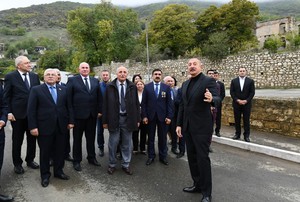
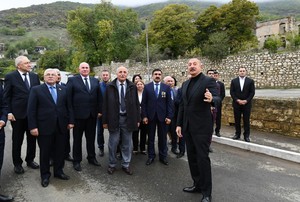
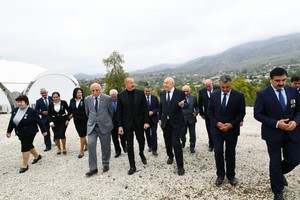
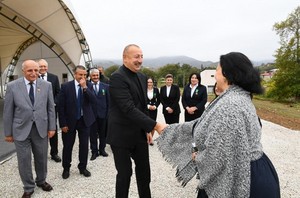
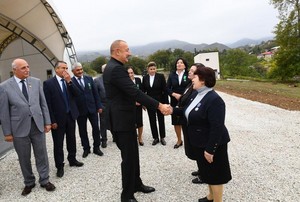
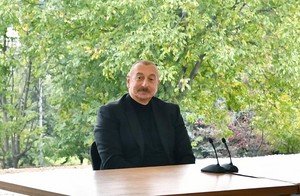
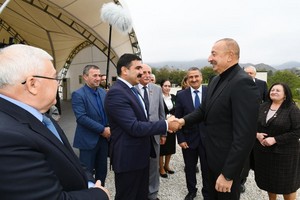
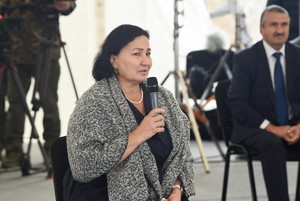
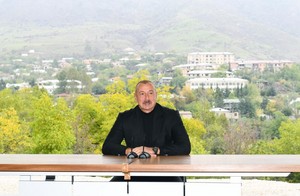
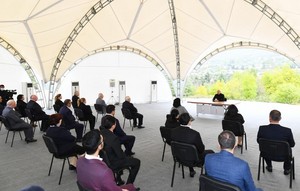
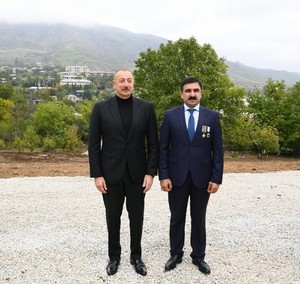
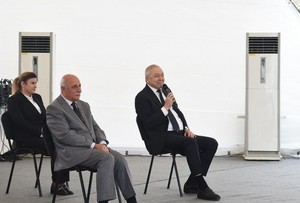

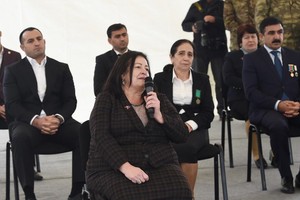
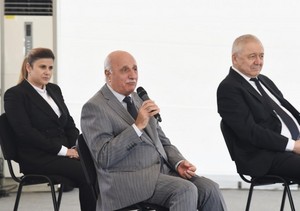
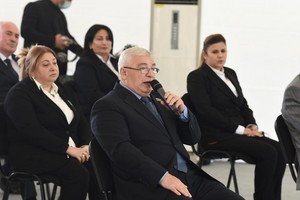
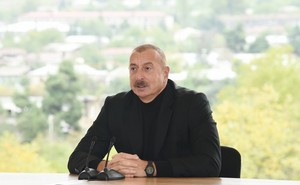
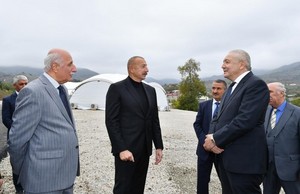
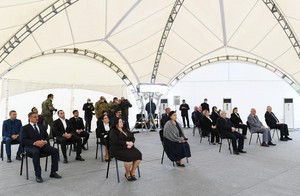
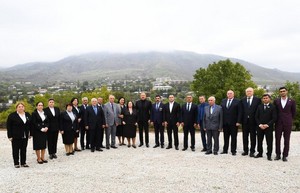


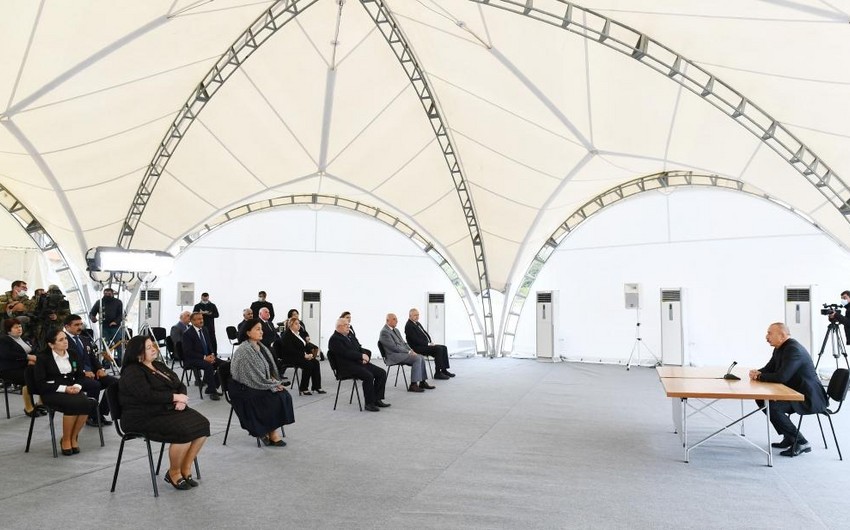 https://static.report.az/photo/9d8e5a34-10e7-38bd-922a-6f714e7f2475.jpg
https://static.report.az/photo/9d8e5a34-10e7-38bd-922a-6f714e7f2475.jpg

